key battery TOYOTA YARIS HATCHBACK 2021 Owners Manual
[x] Cancel search | Manufacturer: TOYOTA, Model Year: 2021, Model line: YARIS HATCHBACK, Model: TOYOTA YARIS HATCHBACK 2021Pages: 568, PDF Size: 110.34 MB
Page 1 of 568
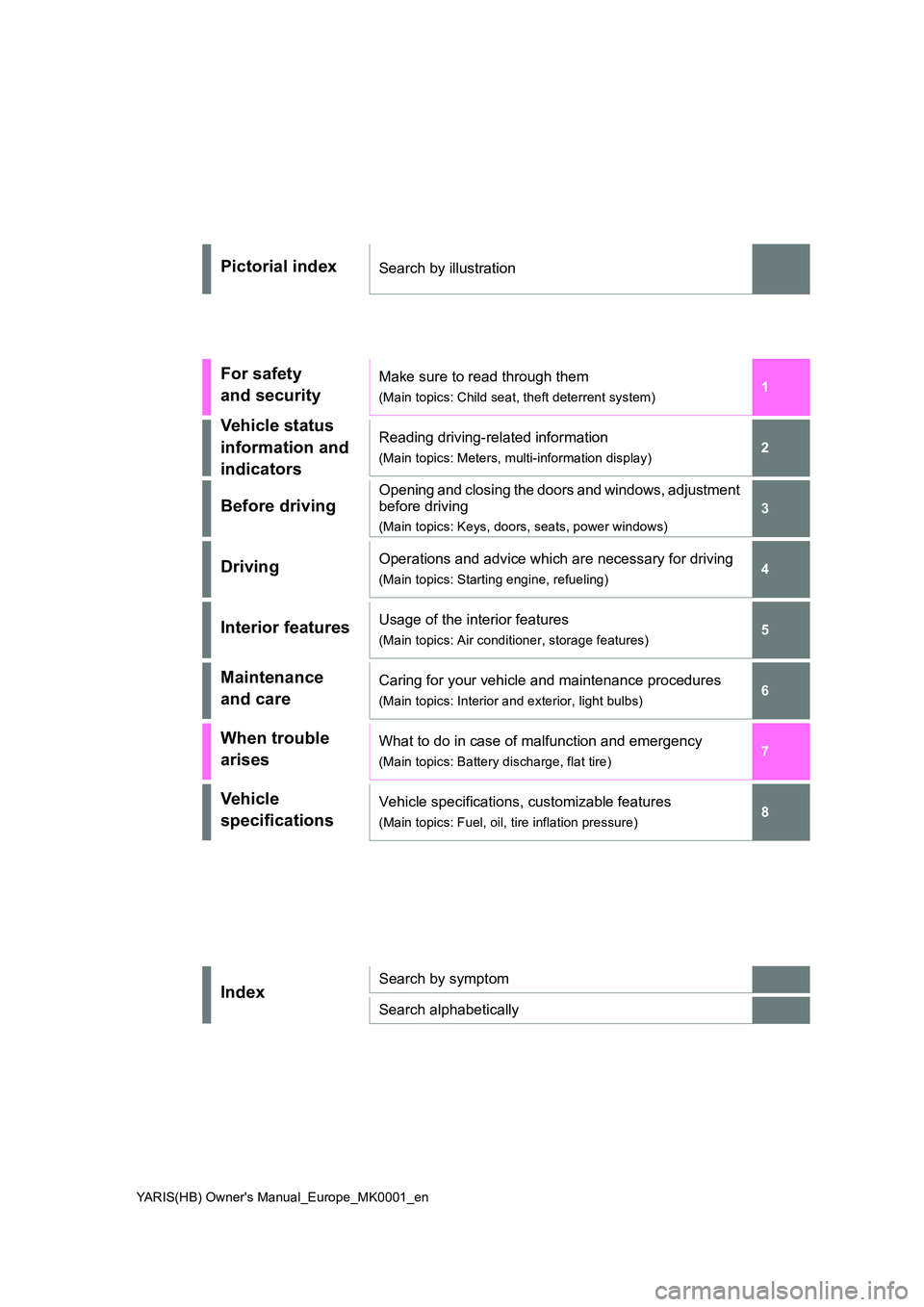
1
6
5
4
3
2
7
YARIS(HB) Owner's Manual_Europe_MK0001_en
8
Pictorial indexSearch by illustration
For safety
and security
Make sure to read through them
(Main topics: Child seat, theft deterrent system)
Vehicle status
information and
indicators
Reading driving-related information
(Main topics: Meters, multi-information display)
Before driving
Opening and closing the doors and windows, adjustment
before driving
(Main topics: Keys, doors, seats, power windows)
DrivingOperations and advice which are necessary for driving
(Main topics: Starting engine, refueling)
Interior featuresUsage of the interior features
(Main topics: Air conditioner, storage features)
Maintenance
and care
Caring for your vehicle and maintenance procedures
(Main topics: Interior and exterior, light bulbs)
When trouble
arises
What to do in case of malfunction and emergency
(Main topics: Battery discharge, flat tire)
Vehicle
specifications
Vehicle specifications, customizable features
(Main topics: Fuel, oil, tire inflation pressure)
IndexSearch by symptom
Search alphabetically
Page 4 of 568
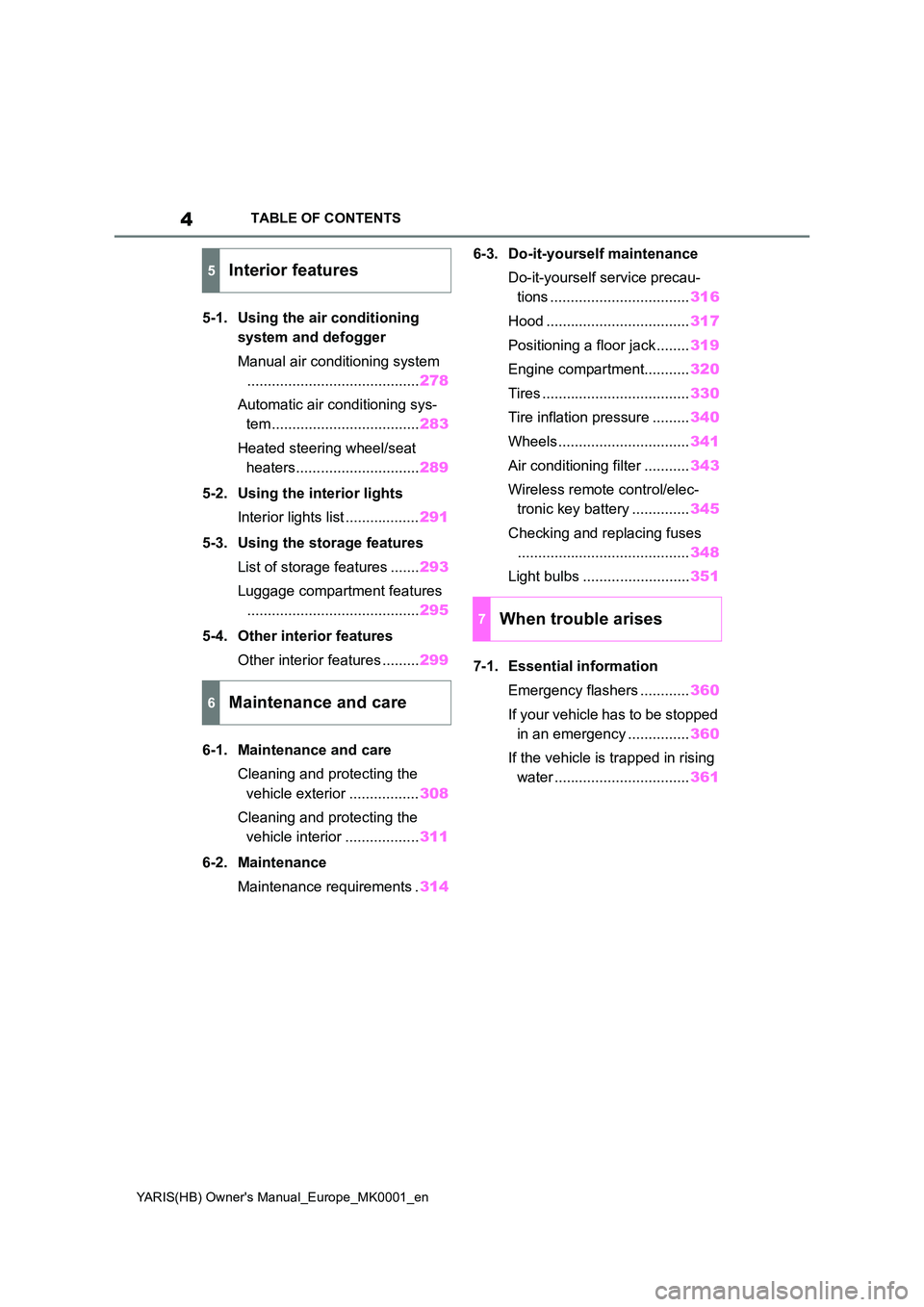
4
YARIS(HB) Owner's Manual_Europe_MK0001_en
TABLE OF CONTENTS
5-1. Using the air conditioning
system and defogger
Manual air conditioning system
.......................................... 278
Automatic air conditioning sys-
tem .................................... 283
Heated steering wheel/seat
heaters.............................. 289
5-2. Using the interior lights
Interior lights list .................. 291
5-3. Using the storage features
List of storage features ....... 293
Luggage compartment features
.......................................... 295
5-4. Other interior features
Other interior features ......... 299
6-1. Maintenance and care
Cleaning and protecting the
vehicle exterior ................. 308
Cleaning and protecting the
vehicle interior .................. 311
6-2. Maintenance
Maintenance requirements . 314
6-3. Do-it-yourself maintenance
Do-it-yourself service precau-
tions .................................. 316
Hood ................................... 317
Positioning a floor jack ........ 319
Engine compartment........... 320
Tires .................................... 330
Tire inflation pressure ......... 340
Wheels ................................ 341
Air conditioning filter ........... 343
Wireless remote control/elec-
tronic key battery .............. 345
Checking and replacing fuses
.......................................... 348
Light bulbs .......................... 351
7-1. Essential information
Emergency flashers ............ 360
If your vehicle has to be stopped
in an emergency ............... 360
If the vehicle is trapped in rising
water ................................. 361
5Interior features
6Maintenance and care
7When trouble arises
Page 5 of 568
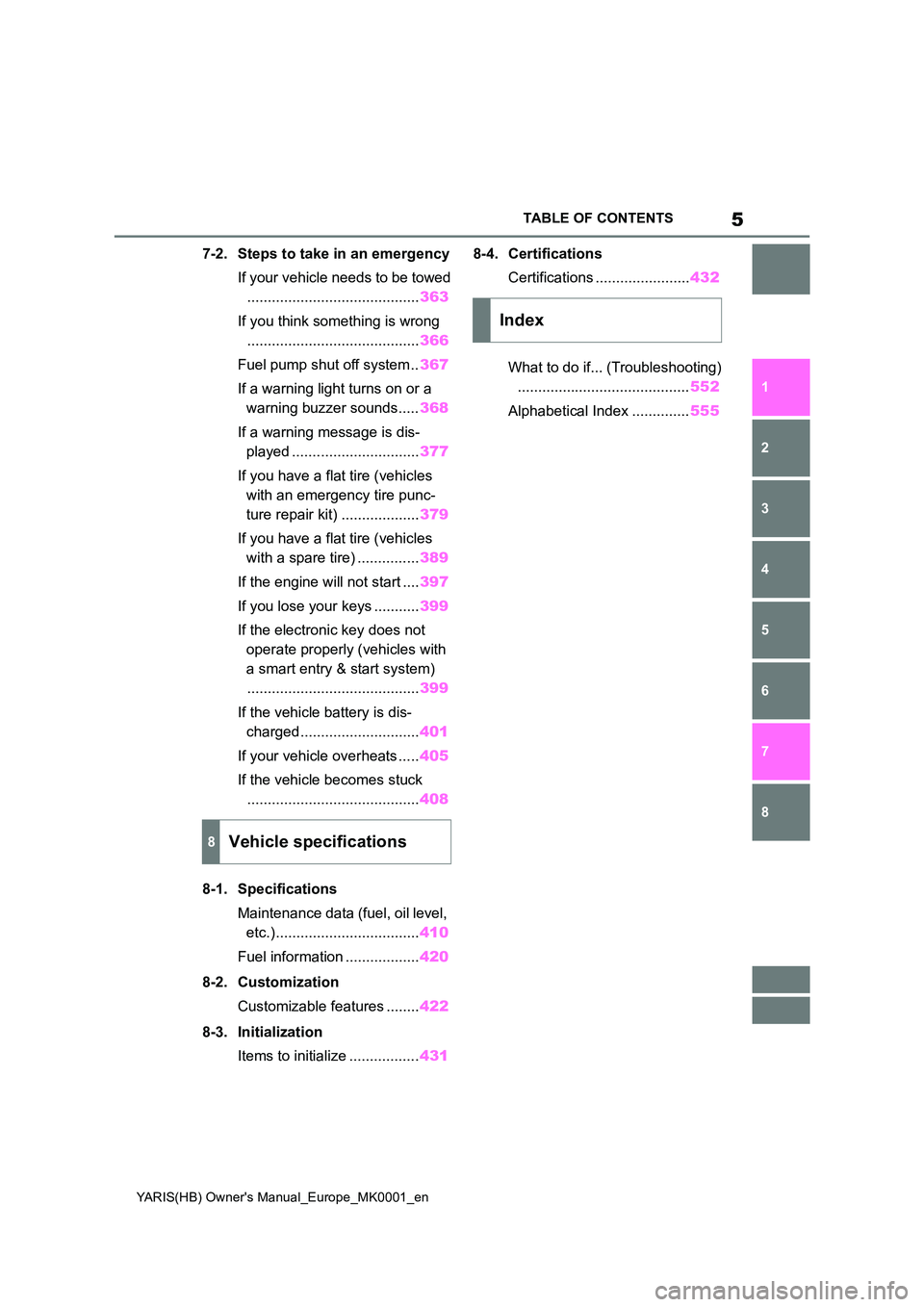
5
YARIS(HB) Owner's Manual_Europe_MK0001_en
TABLE OF CONTENTS
1
6
5
4
3
2
8
7
7-2. Steps to take in an emergency
If your vehicle needs to be towed
.......................................... 363
If you think something is wrong
.......................................... 366
Fuel pump shut off system .. 367
If a warning light turns on or a
warning buzzer sounds..... 368
If a warning message is dis-
played ............................... 377
If you have a flat tire (vehicles
with an emergency tire punc-
ture repair kit) ................... 379
If you have a flat tire (vehicles
with a spare tire) ............... 389
If the engine will not start .... 397
If you lose your keys ........... 399
If the electronic key does not
operate properly (vehicles with
a smart entry & start system)
.......................................... 399
If the vehicle battery is dis-
charged............................. 401
If your vehicle overheats ..... 405
If the vehicle becomes stuck
.......................................... 408
8-1. Specifications
Maintenance data (fuel, oil level,
etc.)................................... 410
Fuel information .................. 420
8-2. Customization
Customizable features ........ 422
8-3. Initialization
Items to initialize ................. 431
8-4. Certifications
Certifications ....................... 432
What to do if... (Troubleshooting)
.......................................... 552
Alphabetical Index .............. 555
8Vehicle specifications
Index
Page 112 of 568
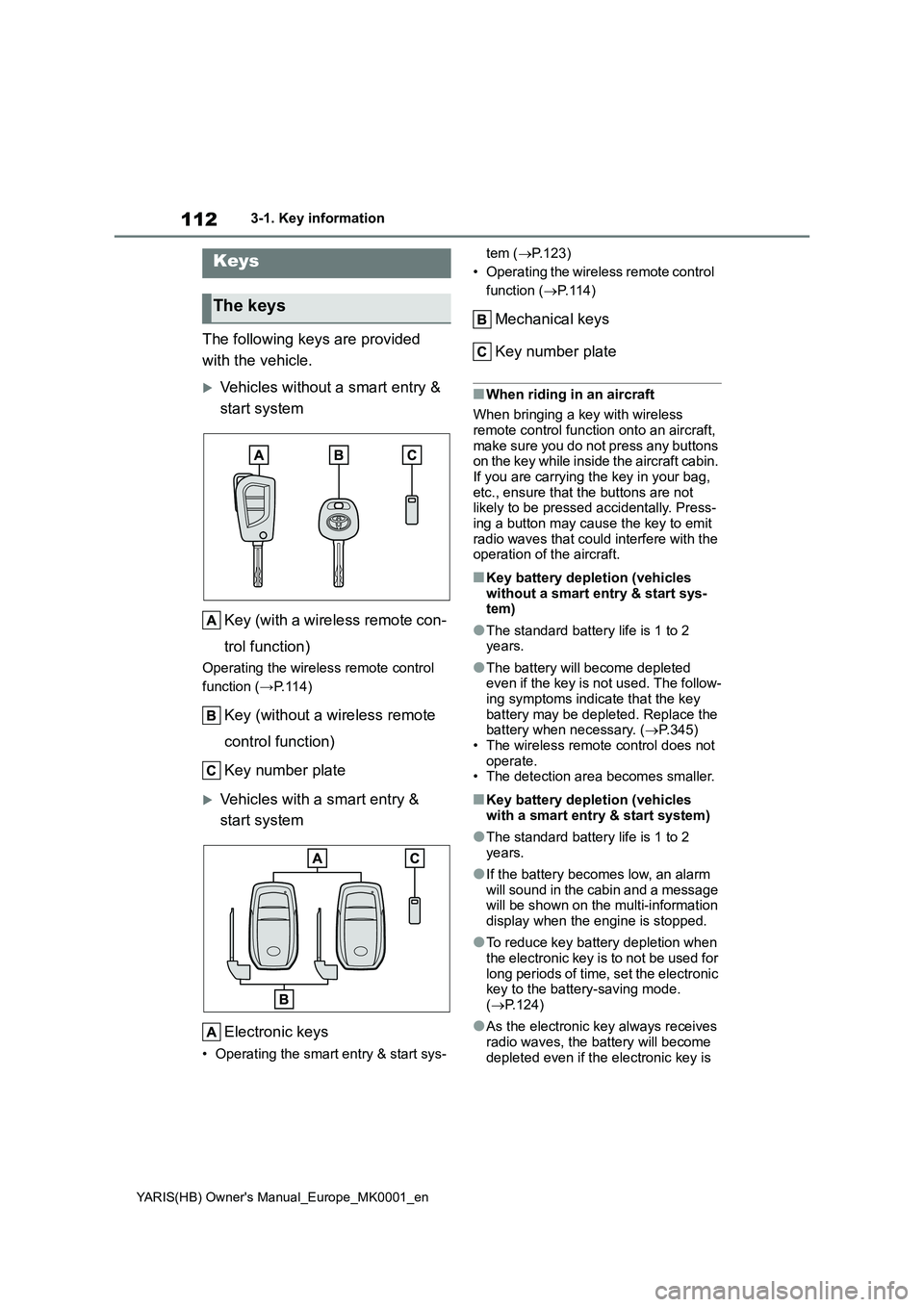
112
YARIS(HB) Owner's Manual_Europe_MK0001_en
3-1. Key information
3-1.Key info rmation
The following keys are provided
with the vehicle.
Vehicles without a smart entry &
start system
Key (with a wireless remote con-
trol function)
Operating the wireless remote control
function (→P.114)
Key (without a wireless remote
control function)
Key number plate
Vehicles with a smart entry &
start system
Electronic keys
• Operating the smart entry & start sys-tem (→P.123)
• Operating the wireless remote control
function (→P. 1 1 4 )
Mechanical keys
Key number plate
■When riding in an aircraft
When bringing a key with wireless
remote control function onto an aircraft,
make sure you do not press any buttons
on the key while inside the aircraft cabin.
If you are carrying the key in your bag,
etc., ensure that the buttons are not
likely to be pressed accidentally. Press-
ing a button may cause the key to emit
radio waves that could interfere with the
operation of the aircraft.
■Key battery depletion (vehicles
without a smart entry & start sys-
tem)
●The standard battery life is 1 to 2
years.
●The battery will become depleted
even if the key is not used. The follow-
ing symptoms indicate that the key
battery may be depleted. Replace the
battery when necessary. (→P.345)
• The wireless remote control does not
operate.
• The detection area becomes smaller.
■Key battery depletion (vehicles
with a smart entry & start system)
●The standard battery life is 1 to 2
years.
●If the battery becomes low, an alarm
will sound in the cabin and a message
will be shown on the multi-information
display when the engine is stopped.
●To reduce key battery depletion when
the electronic key is to not be used for
long periods of time, set the electronic
key to the battery-saving mode.
(→P.124)
●As the electronic key always receives
radio waves, the battery will become
depleted even if the electronic key is
Keys
The keys
Page 113 of 568
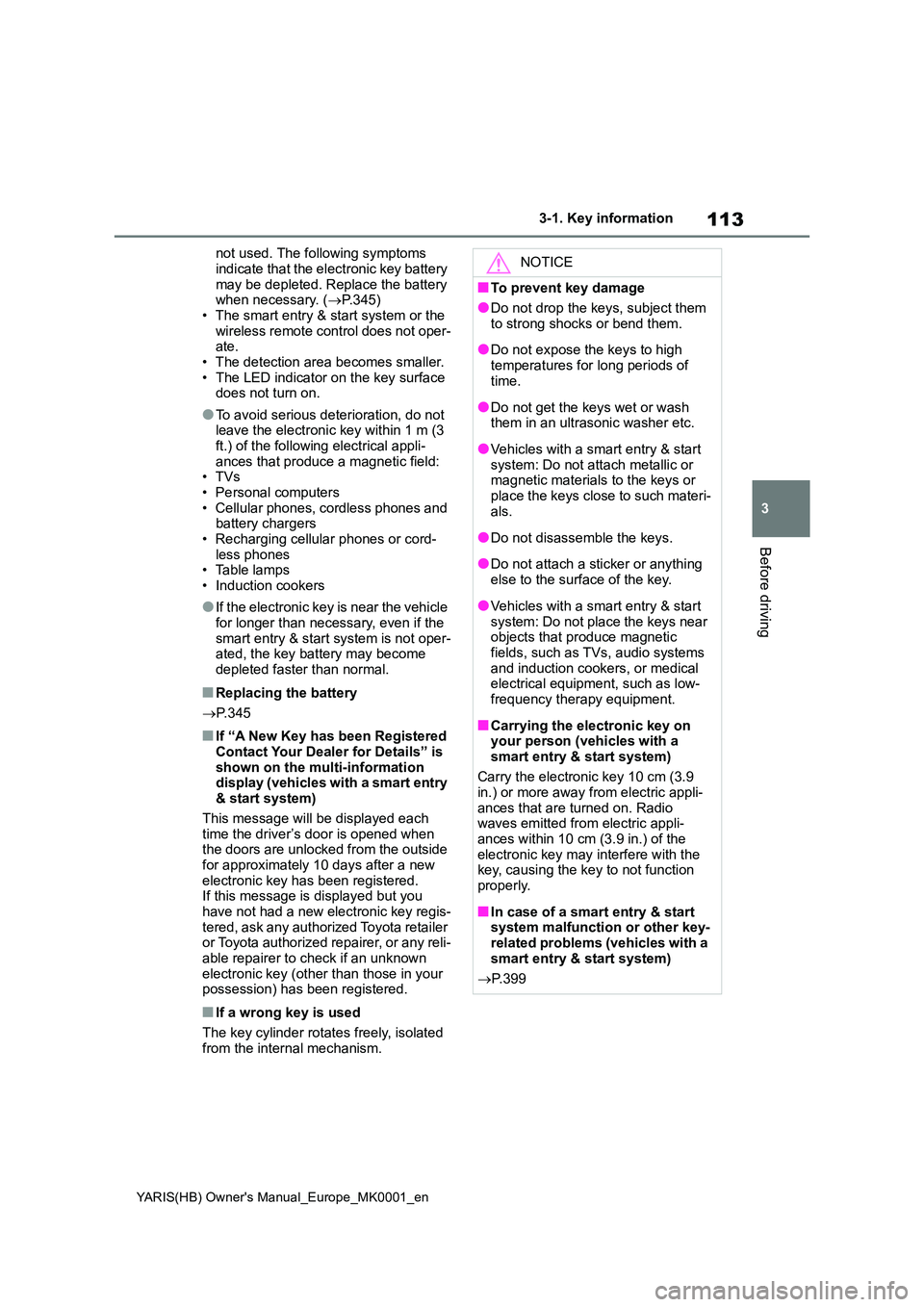
113
3
YARIS(HB) Owner's Manual_Europe_MK0001_en
3-1. Key information
Before driving
not used. The following symptoms
indicate that the electronic key battery may be depleted. Replace the battery when necessary. ( →P.345)
• The smart entry & start system or the wireless remote control does not oper-ate.
• The detection area becomes smaller. • The LED indicator on the key surface does not turn on.
●To avoid serious deterioration, do not leave the electronic key within 1 m (3
ft.) of the following electrical appli- ances that produce a magnetic field:•TVs
• Personal computers • Cellular phones, cordless phones and battery chargers
• Recharging cellular phones or cord- less phones• Table lamps
• Induction cookers
●If the electronic key is near the vehicle
for longer than necessary, even if the smart entry & start system is not oper-ated, the key battery may become
depleted faster than normal.
■Replacing the battery
→ P. 3 4 5
■If “A New Key has been Registered Contact Your Dealer for Details” is
shown on the multi-information display (vehicles with a smart entry & start system)
This message will be displayed each time the driver’s door is opened when the doors are unlocked from the outside
for approximately 10 days after a new electronic key has been registered.If this message is displayed but you
have not had a new electronic key regis- tered, ask any authorized Toyota retailer or Toyota authorized repairer, or any reli-
able repairer to check if an unknown electronic key (other than those in your possession) has been registered.
■If a wrong key is used
The key cylinder rotates freely, isolated from the internal mechanism.
NOTICE
■To prevent key damage
●Do not drop the keys, subject them
to strong shocks or bend them.
●Do not expose the keys to high
temperatures for long periods of time.
●Do not get the keys wet or wash them in an ultrasonic washer etc.
●Vehicles with a smart entry & start system: Do not attach metallic or magnetic materials to the keys or
place the keys close to such materi- als.
●Do not disassemble the keys.
●Do not attach a sticker or anything
else to the surface of the key.
●Vehicles with a smart entry & start
system: Do not place the keys near objects that produce magnetic fields, such as TVs, audio systems
and induction cookers, or medical electrical equipment, such as low-frequency therapy equipment.
■Carrying the electronic key on your person (vehicles with a
smart entry & start system)
Carry the electronic key 10 cm (3.9 in.) or more away from electric appli-
ances that are turned on. Radio waves emitted from electric appli-ances within 10 cm (3.9 in.) of the
electronic key may interfere with the key, causing the key to not function properly.
■In case of a smart entry & start system malfunction or other key-
related problems (vehicles with a smart entry & start system)
→ P. 3 9 9
Page 114 of 568
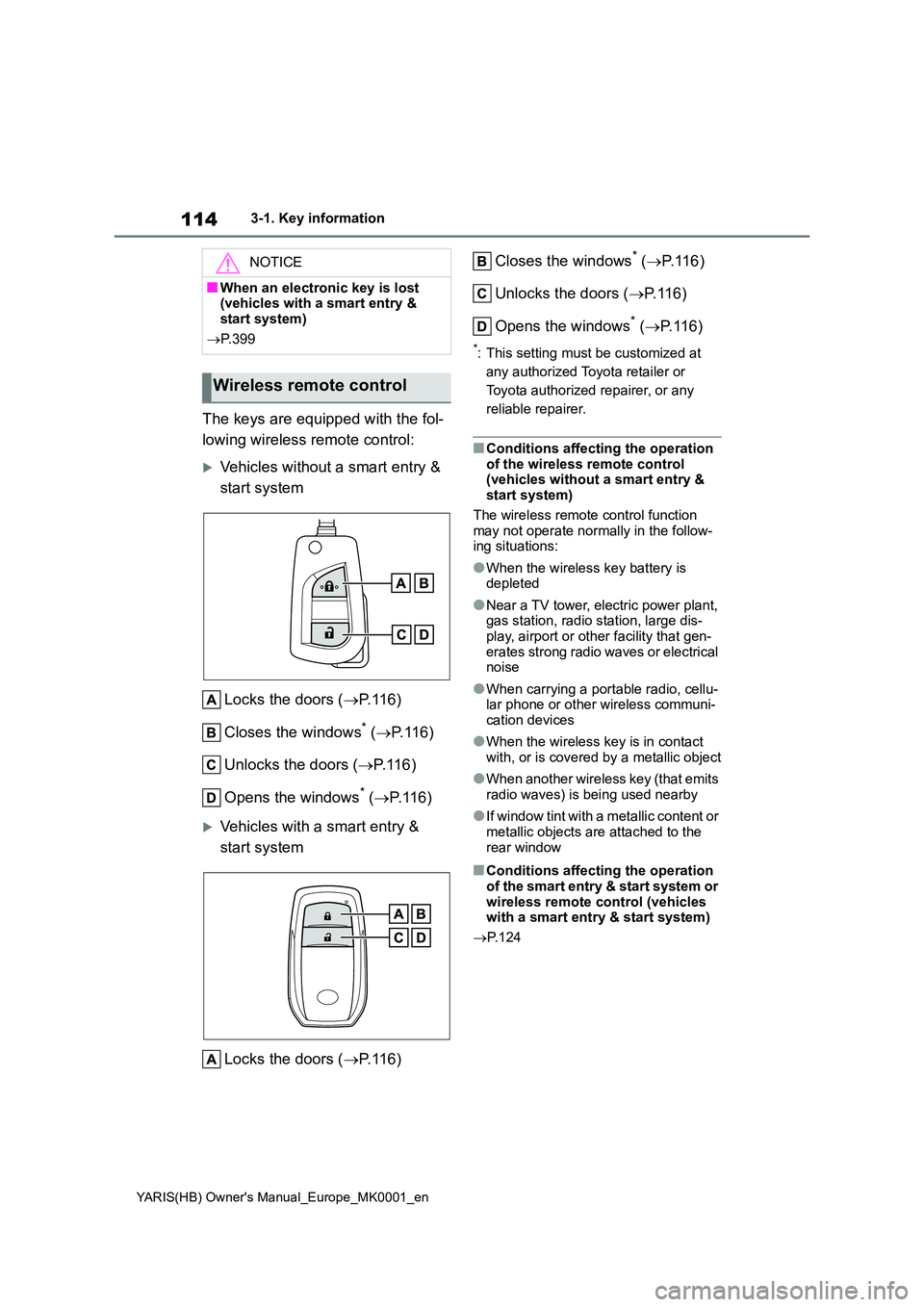
114
YARIS(HB) Owner's Manual_Europe_MK0001_en
3-1. Key information
The keys are equipped with the fol-
lowing wireless remote control:
Vehicles without a smart entry &
start system
Locks the doors ( →P. 1 1 6 )
Closes the windows* ( →P. 1 1 6 )
Unlocks the doors ( →P. 1 1 6 )
Opens the windows* ( →P. 1 1 6 )
Vehicles with a smart entry &
start system
Locks the doors ( →P. 1 1 6 )
Closes the windows* ( →P. 1 1 6 )
Unlocks the doors ( →P. 1 1 6 )
Opens the windows* ( →P. 1 1 6 )
*: This setting must be customized at
any authorized Toyota retailer or
Toyota authorized repairer, or any
reliable repairer.
■Conditions affecting the operation
of the wireless remote control (vehicles without a smart entry & start system)
The wireless remote control function may not operate normally in the follow-ing situations:
●When the wireless key battery is depleted
●Near a TV tower, electric power plant, gas station, radio station, large dis-
play, airport or other facility that gen- erates strong radio waves or electrical noise
●When carrying a portable radio, cellu-lar phone or other wireless communi-
cation devices
●When the wireless key is in contact
with, or is covered by a metallic object
●When another wireless key (that emits
radio waves) is being used nearby
●If window tint with a metallic content or
metallic objects are attached to the rear window
■Conditions affecting the operation of the smart entry & start system or
wireless remote control (vehicles with a smart entry & start system)
→ P. 1 2 4
NOTICE
■When an electronic key is lost (vehicles with a smart entry &
start system)
→ P. 3 9 9
Wireless remote control
Page 115 of 568
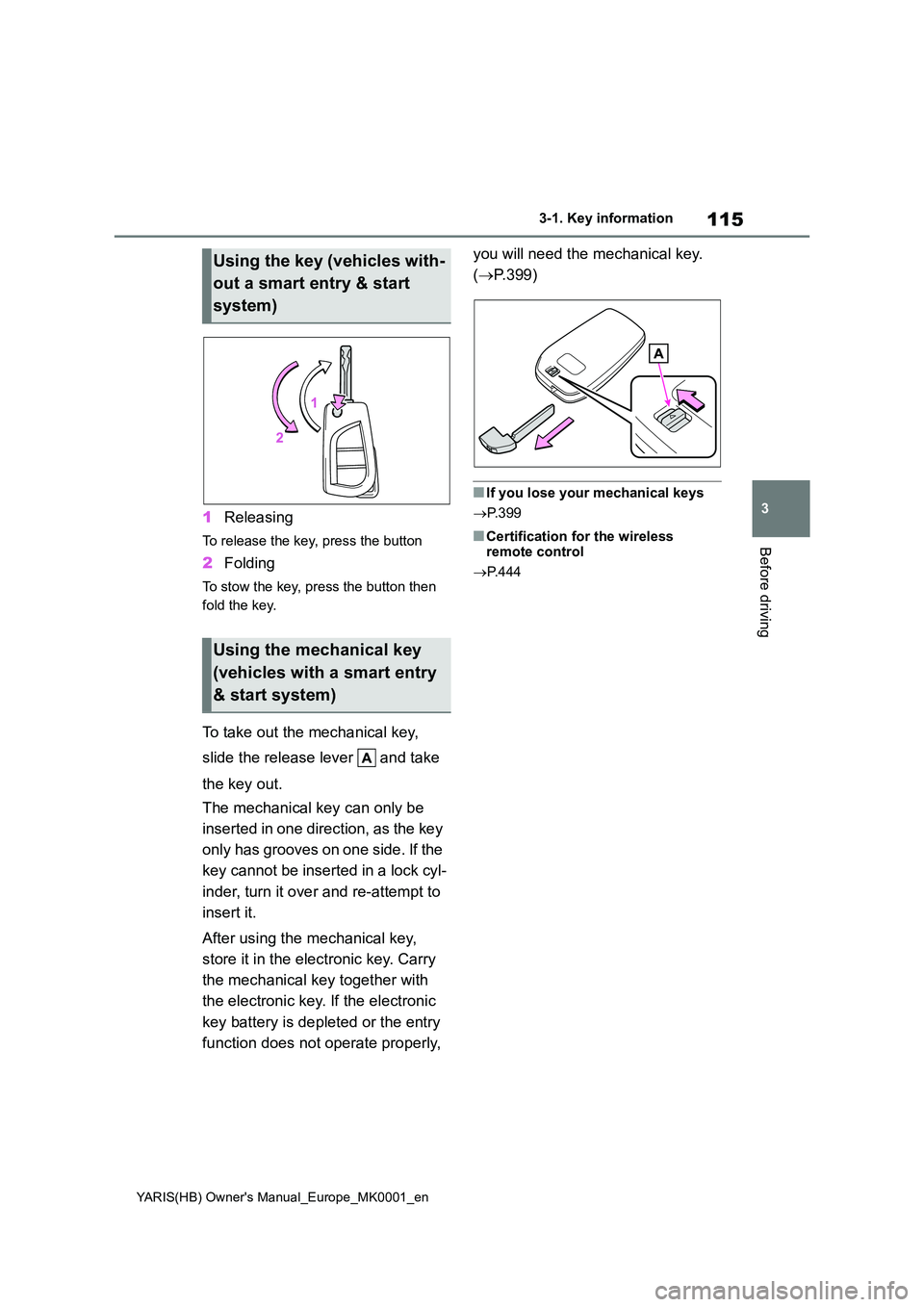
115
3
YARIS(HB) Owner's Manual_Europe_MK0001_en
3-1. Key information
Before driving
1Releasing
To release the key, press the button
2Folding
To stow the key, press the button then
fold the key.
To take out the mechanical key,
slide the release lever and take
the key out.
The mechanical key can only be
inserted in one direction, as the key
only has grooves on one side. If the
key cannot be inserted in a lock cyl-
inder, turn it over and re-attempt to
insert it.
After using the mechanical key,
store it in the electronic key. Carry
the mechanical key together with
the electronic key. If the electronic
key battery is depleted or the entry
function does not operate properly,
you will need the mechanical key.
( →P.399)
■If you lose your mechanical keys
→ P. 3 9 9
■Certification for the wireless remote control
→ P. 4 4 4
Using the key (vehicles with-
out a smart entry & start
system)
Using the mechanical key
(vehicles with a smart entry
& start system)
Page 118 of 568
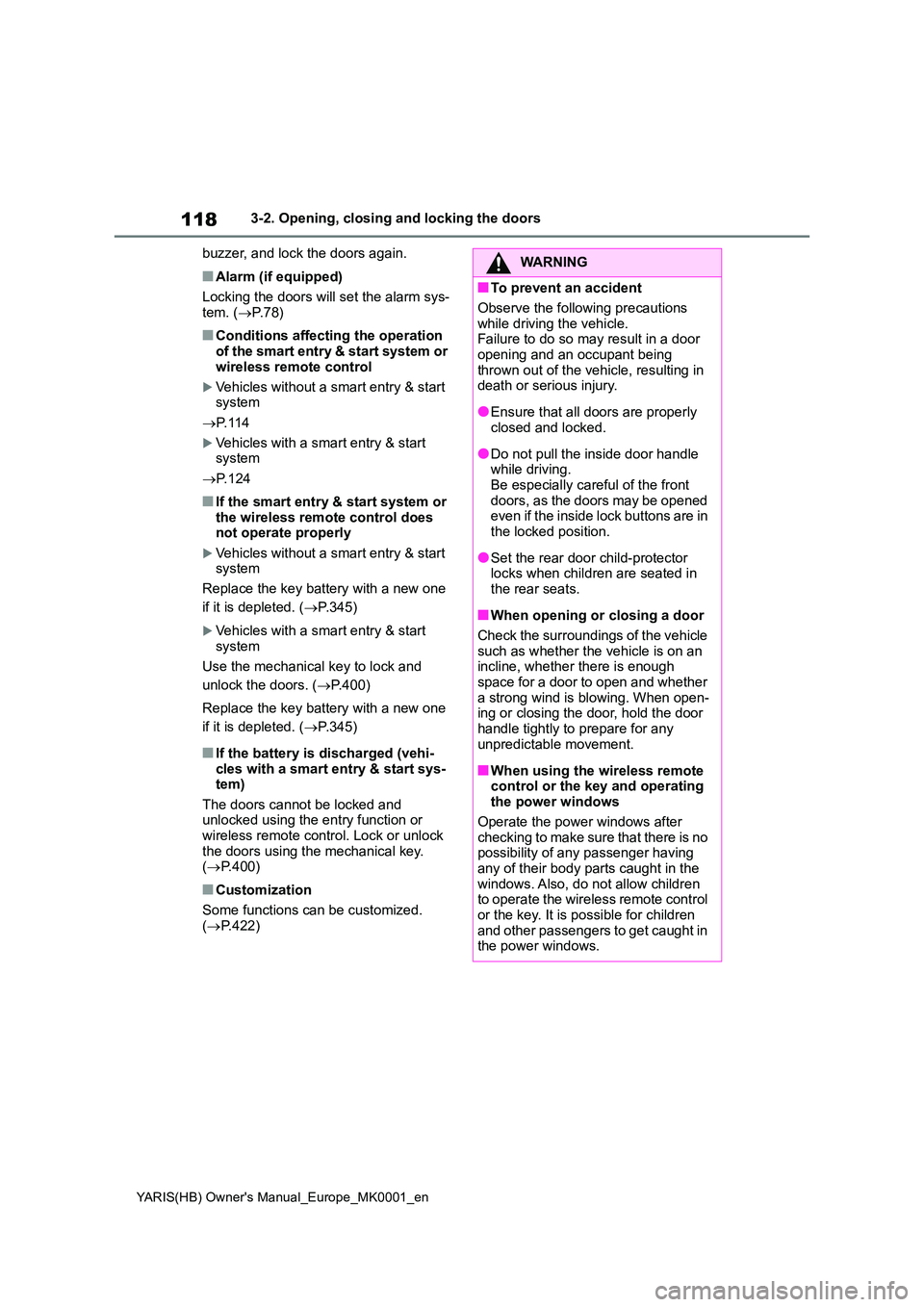
118
YARIS(HB) Owner's Manual_Europe_MK0001_en
3-2. Opening, closing and locking the doors
buzzer, and lock the doors again.
■Alarm (if equipped)
Locking the doors will set the alarm sys- tem. ( →P.78)
■Conditions affecting the operation of the smart entry & start system or
wireless remote control
Vehicles without a smart entry & start system
→ P. 1 1 4
Vehicles with a smart entry & start system
→ P. 1 2 4
■If the smart entry & start system or the wireless remote control does not operate properly
Vehicles without a smart entry & start system
Replace the key battery with a new one
if it is depleted. ( →P.345)
Vehicles with a smart entry & start
system
Use the mechanical key to lock and
unlock the doors. ( →P.400)
Replace the key battery with a new one
if it is depleted. ( →P.345)
■If the battery is discharged (vehi- cles with a smart entry & start sys-tem)
The doors cannot be locked and unlocked using the entry function or wireless remote control. Lock or unlock
the doors using the mechanical key. ( →P.400)
■Customization
Some functions can be customized.
( →P.422)
WARNING
■To prevent an accident
Observe the following precautions
while driving the vehicle. Failure to do so may result in a door opening and an occupant being
thrown out of the vehicle, resulting in death or serious injury.
●Ensure that all doors are properly closed and locked.
●Do not pull the inside door handle while driving.Be especially careful of the front
doors, as the doors may be opened even if the inside lock buttons are in the locked position.
●Set the rear door child-protector locks when children are seated in
the rear seats.
■When opening or closing a door
Check the surroundings of the vehicle such as whether the vehicle is on an incline, whether there is enough
space for a door to open and whether a strong wind is blowing. When open-ing or closing the door, hold the door
handle tightly to prepare for any unpredictable movement.
■When using the wireless remote control or the key and operating the power windows
Operate the power windows after checking to make sure that there is no possibility of any passenger having
any of their body parts caught in the windows. Also, do not allow children to operate the wireless remote control
or the key. It is possible for children and other passengers to get caught in the power windows.
Page 124 of 568
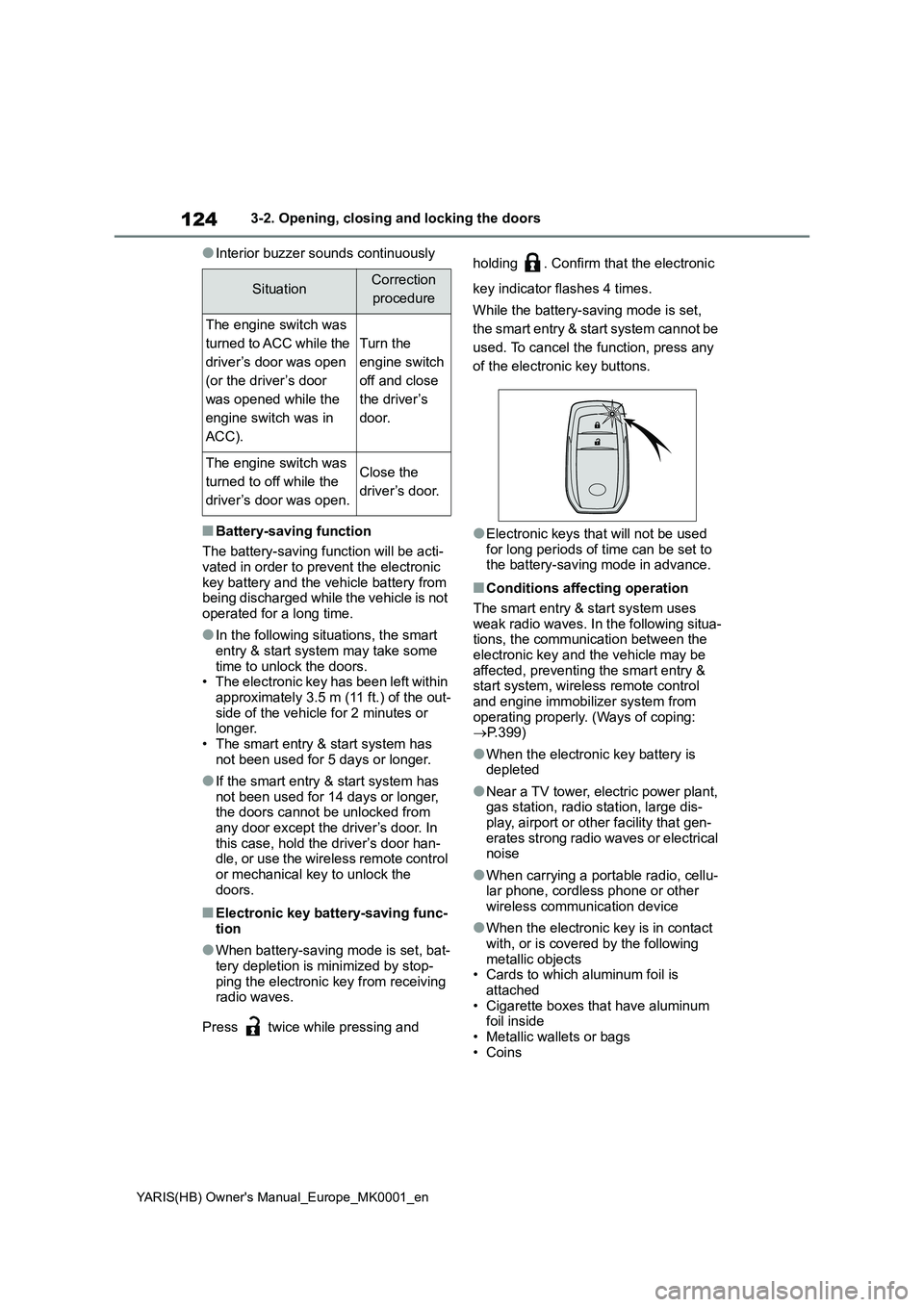
124
YARIS(HB) Owner's Manual_Europe_MK0001_en
3-2. Opening, closing and locking the doors
●Interior buzzer sounds continuously
■Battery-saving function
The battery-saving function will be acti-
vated in order to prevent the electronic
key battery and the vehicle battery from
being discharged while the vehicle is not
operated for a long time.
●In the following situations, the smart
entry & start system may take some
time to unlock the doors.
• The electronic key has been left within
approximately 3.5 m (11 ft.) of the out-
side of the vehicle for 2 minutes or
longer.
• The smart entry & start system has
not been used for 5 days or longer.
●If the smart entry & start system has
not been used for 14 days or longer,
the doors cannot be unlocked from
any door except the driver’s door. In
this case, hold the driver’s door han-
dle, or use the wireless remote control
or mechanical key to unlock the
doors.
■Electronic key battery-saving func-
tion
●When battery-saving mode is set, bat-
tery depletion is minimized by stop-
ping the electronic key from receiving
radio waves.
Press twice while pressing and holding . Confirm that the electronic
key indicator flashes 4 times.
While the battery-saving mode is set,
the smart entry & start system cannot be
used. To cancel the function, press any
of the electronic key buttons.
●Electronic keys that will not be used
for long periods of time can be set to
the battery-saving mode in advance.
■Conditions affecting operation
The smart entry & start system uses
weak radio waves. In the following situa-
tions, the communication between the
electronic key and the vehicle may be
affected, preventing the smart entry &
start system, wireless remote control
and engine immobilizer system from
operating properly. (Ways of coping:
→P.399)
●When the electronic key battery is
depleted
●Near a TV tower, electric power plant,
gas station, radio station, large dis-
play, airport or other facility that gen-
erates strong radio waves or electrical
noise
●When carrying a portable radio, cellu-
lar phone, cordless phone or other
wireless communication device
●When the electronic key is in contact
with, or is covered by the following
metallic objects
• Cards to which aluminum foil is
attached
• Cigarette boxes that have aluminum
foil inside
• Metallic wallets or bags
•Coins
SituationCorrection
procedure
The engine switch was
turned to ACC while the
driver’s door was open
(or the driver’s door
was opened while the
engine switch was in
ACC).
Turn the
engine switch
off and close
the driver’s
door.
The engine switch was
turned to off while the
driver’s door was open.Close the
driver ’s door.
Page 125 of 568
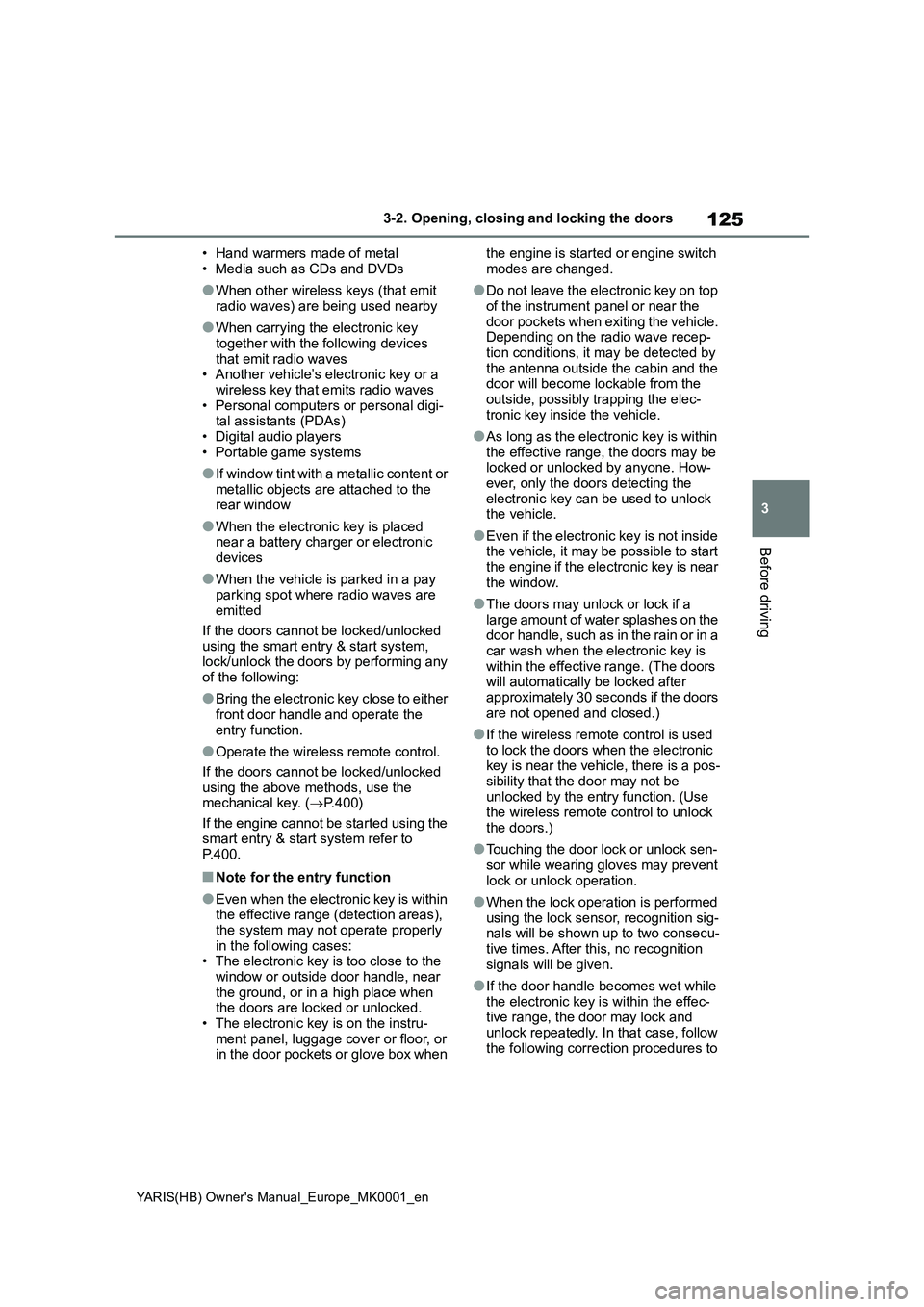
125
3
YARIS(HB) Owner's Manual_Europe_MK0001_en
3-2. Opening, closing and locking the doors
Before driving
• Hand warmers made of metal
• Media such as CDs and DVDs
●When other wireless keys (that emit
radio waves) are being used nearby
●When carrying the electronic key
together with the following devices
that emit radio waves
• Another vehicle’s electronic key or a
wireless key that emits radio waves
• Personal computers or personal digi-
tal assistants (PDAs)
• Digital audio players
• Portable game systems
●If window tint with a metallic content or
metallic objects are attached to the
rear window
●When the electronic key is placed
near a battery charger or electronic
devices
●When the vehicle is parked in a pay
parking spot where radio waves are
emitted
If the doors cannot be locked/unlocked
using the smart entry & start system,
lock/unlock the doors by performing any
of the following:
●Bring the electronic key close to either
front door handle and operate the
entry function.
●Operate the wireless remote control.
If the doors cannot be locked/unlocked
using the above methods, use the
mechanical key. (→P.400)
If the engine cannot be started using the
smart entry & start system refer to
P.400.
■Note for the entry function
●Even when the electronic key is within
the effective range (detection areas),
the system may not operate properly
in the following cases:
• The electronic key is too close to the
window or outside door handle, near
the ground, or in a high place when
the doors are locked or unlocked.
• The electronic key is on the instru-
ment panel, luggage cover or floor, or
in the door pockets or glove box when the engine is started or engine switch
modes are changed.
●Do not leave the electronic key on top
of the instrument panel or near the
door pockets when exiting the vehicle.
Depending on the radio wave recep-
tion conditions, it may be detected by
the antenna outside the cabin and the
door will become lockable from the
outside, possibly trapping the elec-
tronic key inside the vehicle.
●As long as the electronic key is within
the effective range, the doors may be
locked or unlocked by anyone. How-
ever, only the doors detecting the
electronic key can be used to unlock
the vehicle.
●Even if the electronic key is not inside
the vehicle, it may be possible to start
the engine if the electronic key is near
the window.
●The doors may unlock or lock if a
large amount of water splashes on the
door handle, such as in the rain or in a
car wash when the electronic key is
within the effective range. (The doors
will automatically be locked after
approximately 30 seconds if the doors
are not opened and closed.)
●If the wireless remote control is used
to lock the doors when the electronic
key is near the vehicle, there is a pos-
sibility that the door may not be
unlocked by the entry function. (Use
the wireless remote control to unlock
the doors.)
●Touching the door lock or unlock sen-
sor while wearing gloves may prevent
lock or unlock operation.
●When the lock operation is performed
using the lock sensor, recognition sig-
nals will be shown up to two consecu-
tive times. After this, no recognition
signals will be given.
●If the door handle becomes wet while
the electronic key is within the effec-
tive range, the door may lock and
unlock repeatedly. In that case, follow
the following correction procedures to